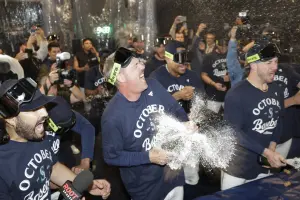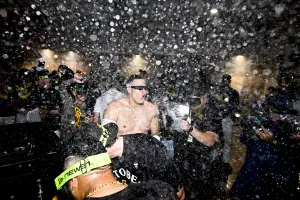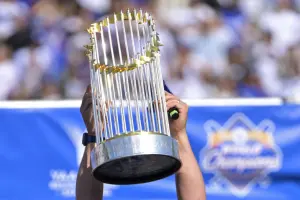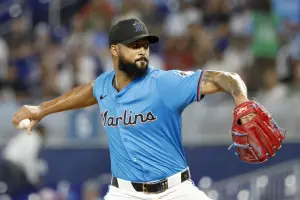
GM's OFFICE: Innovating around the catcher pool
We have mentioned it a couple of times in this space before, but by way of a refresh: there was a significant new entry in the slate of industry competitions this season. Started by Justin Mason of FriendsWithFantasyBenefits.com, The Great Fantasy Baseball Invitational created an NFBC-style, multi-league competition among industry writers. 195 industry writers/analysts entered, and were separated into (13) 15-team 5x5 leagues, and set up to compete for league titles as well as an overall title.
It's been an interesting format: our BHQ staff jumped in with strong representation; we have 14 writers competing. (And competing very well... more on that later.)
Industry leagues are often a laboratory, both for individual strategies and for league rules/configuration. Tout Wars has long been at the bleeding edge of innovation. Tout was at the forefront of the move from BA to OBP as a category, to Vickrey FAAB (and back), to a "swing" (pitcher or hitter) lineup spot, to lowering position eligibility requirements from 20 games to 15... just to name a few of their experiments.
In that spirit of innovation, TGFBI had one significant wrinkle in place for their inaugural season: they changed the traditional 14-man active hitting roster, by taking the 2nd C position and converting it into a second UT spot.
I consider myself a traditionalist. Yes, the catcher pool has been a cesspool for as long as I can remember, but everyone has to fish in the same murky waters. While I hate dealing with catchers as much as the next guy, I wasn't exactly clamoring for this change. This seemed like a concession, a "dumbing down" of sorts. (Picture the "old man shaking fist at cloud" meme: "In my day, we rostered two catchers. Kids these days! Get off my lawn!")
But, after playing (most of) this season with this format, I have changed my mind. This change is for the better, and I endorse it wholeheartedly.
Here are some reasons why...
This is not a new problem
It may seem like the catcher pool is worse than it's ever been. That would probably have been my off-the-cuff impression before I went down this rabbit hole. Just for fun, I asked the question on Twitter earlier this week:
Working on an article for later this week about the fantasy value of the catcher pool. Which statement below best captures your impression of the current catcher pool in terms of fantasy value?
— Ray Murphy (@RayHQ) August 13, 2018
After firing that tweet, I went and pulled a decade's worth of data from our Custom Draft Guide, to put some actual numbers around the question. Just to mirror TGFBI's format, I used 15-team mixed 5x5 as my setup. Importantly, I did not use the 'force positions' option in the CDG, which would mandate that enough catchers are positively-valued to meet the roster requirements of the league. So, these results are just a straight Top 210 hitters (14 roster spots, 15 teams) by value, measuring how many catchers crack that Top 210 (and at what valuation within):
Here are the results: (2018 data thru 8/12; data is inclusive, i.e. all of the $5+ Cs are also counted as $1 Cs, and so on)
| 2018 | 2017 | 2016 | 2015 | 2014 | 2013 | 2012 | 2011 | 2010 | 2009 | 2008 | |
| $1+ Cs | 11 | 9 | 13 | 14 | 19 | 19 | 19 | 17 | 14 | 14 | 15 |
| $5+ Cs | 7 | 6 | 6 | 9 | 11 | 13 | 11 | 9 | 7 | 10 | 7 |
| $10+ Cs | 3 | 4 | 4 | 1 | 5 | 8 | 7 | 7 | 4 | 4 | 5 |
| $15+ Cs | 0 | 1 | 1 | 1 | 2 | 2 | 3 | 2 | 2 | 2 | 2 |
| $20+ Cs | 0 | 0 | 0 | 1 | 1 | 0 | 1 | 2 | 0 | 1 | 0 |
| Total Value | $ 88 | $ 87 | $ 104 | $ 104 | $ 158 | $ 182 | $ 180 | $ 150 | $ 103 | $ 132 | $ 123 |
To answer that Twitter question: Yes, this seems to be the worst year for catchers in the last decade. To me, though, it seems like that's the wrong takeaway from this chart. Rather, it's just rather stunning to look at how bad this position has been, for how long. Consider:
- We haven't had a $20 catcher in three years, and only once in the past decade have we seen two in a single year.
- This year is on pace to not yield a single $15 catcher for the first time in our sample. But only once in this period have we seen more than two of those in a single season.
- If your preferred standard is just "I'll take any positive value from the position", you have to go back four years to find a time where there were enough positive-valued catchers to put even one such catcher on every team in a 15-team mixed league.
- And not once in this 11-year sample have there been enough $5+ catchers to put one on every team in a 15-team league. And we've never even come close to having two per team.
- Even the relative "glory days" of 2012-15 were pretty significantly goosed by just one player, as Buster Posey's values through those years ($25-$13-$23-$23) prop up the total values in that time period.
- I probably don't need to create another table to convince -only leaguers how much worse things are in that universe.
When you put the player pool in such stark relief here, I can't help but ask "why are we doing this to ourselves?" We have enough data here to see that this isn't just a blip in the player development cycle. MLB organizations are clearly valuing non-fantasy skills (game-calling and pitch-framing) over offense from their backstops.
In fact, the tolerance level of what minimal level of defensive catching skill they find tolerable seems to be rising, regardless of offensive ability. Consider two pseudo-catchers on good teams and widely-acclaimed "smart" organizations:
- In Cleveland, the Indians apparently decided that Francisco Mejía was never going to meet their standards for a defensive catcher. They tried him at a couple of other positions, and when that didn't work out, they decided to use him as a trade chip.
- In Boston, the Red Sox are 50 games over .500 and have a 10-game lead in their division. Their primary catchers, Sandy León and Christian Vázquez, both have a sub-.600 OPS. The latter has been on the DL for more than a month. Despite that level of ineptitude at the plate, pseudo-catcher Blake Swihart (who admittedly hasn't hit much better than the other two this year, but is clearly a better hitter historically) has put on the catcher's gear all of four times this season.
Point being, not only do we have a decade's worth of data to confirm what we already know, but the industry trend line continues to point in the same direction. So I ask again: Why are we continuing to bang our heads against this wall?
If you still think that a 1-C league (especially a mixed league) is somehow an abomination against the founders, consider some of my anecdotal experiences this year:
TGFBI (1-C): In light of the 1-C format, I waited until the last round of the draft to roster a C. I selected Travis d'Arnaud, figuring that he might be marginally more useful than other end-gamers until he inevitably got hurt, in which case I'd play the FA pool until I found something I liked. I ended up pivoting to Francisco Cervelli early on, and stuck with him. When he landed on the DL, I picked up Yan Gomes for a few weeks. Interestingly, Gomes is currently valued as a $0 player in the 15-mixed format, meaning he's exactly at the replacement player line... or, exactly as bad as you would expect an injury replacement to be at any other position.
Tout Wars (2-C): Tout is an OBP format, which drove my catching choices back in March: I drafted Austin Barnes and Jonathan Lucroy as semi-punts of the position who in theory wouldn't hurt my OBP. After Barnes played so sparingly (and badly) in the first half to negate any OBP value, I dumped him for part-timer Nick Hundley.
LABR (2-C): I started the year with Mike Zunino and Russell Martin. In desperation, I dumped Martin for the aforementioned Leon when he took over the lead role in Boston. He hasn't helped.
NFBC (2-C): One spot in this 2-C format has been held down all year by Cervelli, who we picked up in the final round of the draft. He was paired with Barnes initially, then Hundley, and now Mitch Garver. When Cervelli was DL'd, we tried Kevin Plawecki for a few unexciting weeks. Now that Cervelli is fighting concussion symptoms again, this week we picked up Swihart as a bit of insurance. Despite no meaningful contributions from anyone besides Cervelli, we're doing just fine: we have a 20-point lead in the league and currently sit in the Top 10 of the overall standings.
Which of these is more satisfying as a player? I'd argue TGFBI, where I at least settled on a positive contributor. My reward for that was saving further churn (and FAAB expenditure) trying to find a hot hand. This isn't a case of being against churn... I'm fine with working the free agent pool, if there are positive contributors, some wheat among the chaff, waiting to be plucked. But in these 2-C leagues, that's very rarely the case: note the stampede to pick up Isaiah Kiner-Falefa when he picked up his 10th game at C a few weeks ago. He, like Gomes, is a $0 player without adjusting for position. But in the current catcher pool, a $0 player is a significant upgrade for just about every team.
We haven't even talked about the merits of a 2nd utility spot: roster constraints seem to be opening up in general, thanks to the proliferation of multi-position players. But a 2nd UT spot really does open up the chess board even further. If you want to use that spot strategically, to roster combinations of players you couldn't before (like, say, 5 corner infielders or 7 outfielders), you can do that. It also reduces the penalty for rostering DH-only players... we don't have many of those anymore, but that still seems like a good thing.
The bottom line: more flexibility, that allows more discretion and creativity in how we manage our teams, is something I'll almost always endorse. For all of these reasons, this rule change has my "two thumbs up" and I suggest it to all of your rules committees this offseason: 1 C, 2 UT.
Speaking of industry competitions...
As I mentioned above, our staff is rolling in TGFBI. We have 14 entries in the 13 leagues. Seven of those 14 are sitting first or second in their leagues, ranking in the overall top 25 (of 195 entries). Here is a snapshot of the BHQ representatives in the Top 25, led by current overall competition leader Brian Rudd:
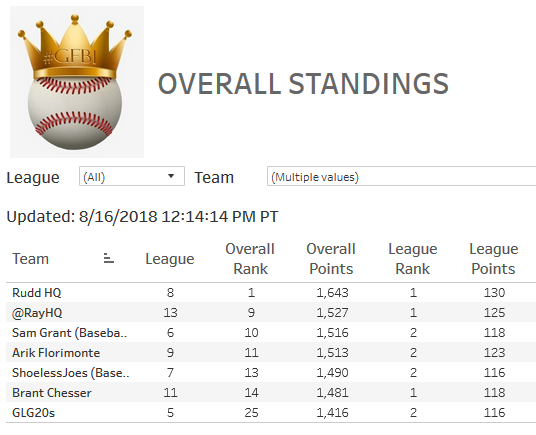
Another fun wrinkle in the TGFBI data set is that they roll up all of the entries to rank the overall performance of the competing sites who have multiple entries. We have spent the summer locked in a back-and-forth duel with Rotowire for the lead in that competition:
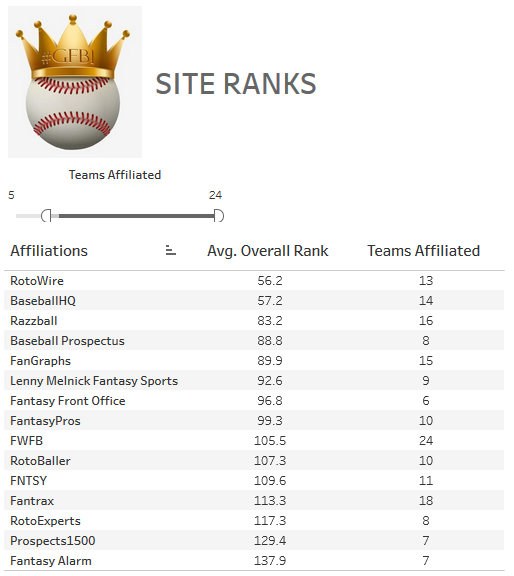
Lots of chances for money finishes there. And a few more beyond TGFBI:
LABR:
- Dave Adler is sitting in second in the AL league, just a couple of points out of first in a tight multi-team race.
- Doug Dennis is currently 8th in the NL league, expecting to finish anywhere from 5th to 10th.
- I am sitting in 9th in LABR-Mixed, having been somewhere around the middle of the pack all year, with little sign of that changing.
Tout Wars
- Phil Hertz is 5th in Tout-NL, with a shot at 2nd or 3rd.
- Doug Dennis is 9th in Tout-AL, without much upside from there.
- Patrick Davitt is also in Tout-AL, where he recently climbed out of the cellar and up to 11th... no small achievement given where he was early on.
- I'm in the Tout-Mixed draft format (discussed here), and have managed to scratch from 14th to 11th, with maybe a little more headroom available.
- Brent handled the Tout-Mixed auction format, and currently sits in 11th place.
Other leagues of note:
- CBS Sportsline: Brent is in 2nd in the AL-only league, just a half-point out of first. Brant Chesser is leading both the NL-only counterpart and the H2H version.
- Fantasy Sports Trade Association: Brent and I drafted this one together, and we're currently in 2nd and trying to run down the leaders (Glenn Colton/Rick Wolf)
We'll circle back with updates down the stretch where warranted, and post-mortems as well.


